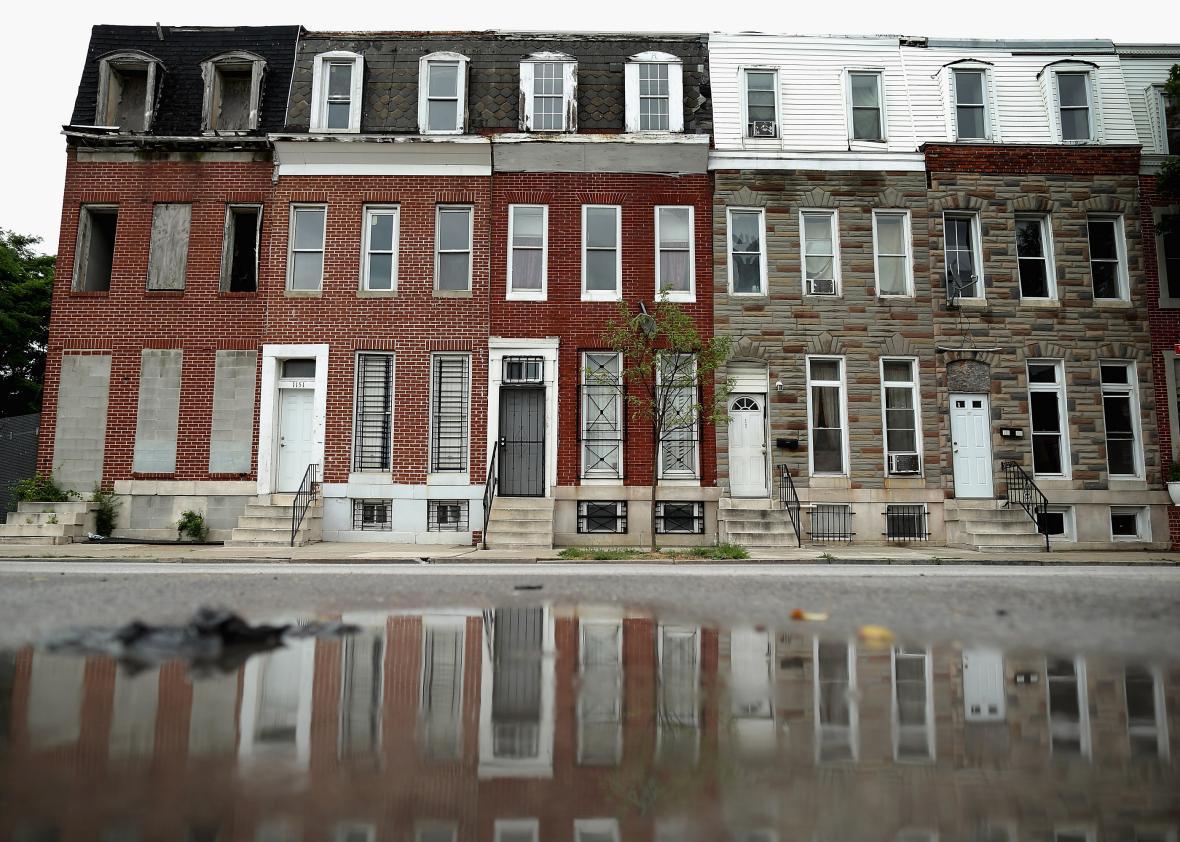When a case arrives in court and only one side can retain legal counsel, the outcome tends to favor the side that can afford a lawyer. Due to cuts to legal-aid programs, low-income tenants are only very rarely able to bring legal representation to housing cases. By contrast, in many jurisdictions, 85 to 90 percent of landlords are backed by a lawyer.
A study released Monday by the Public Justice Center, a civil legal-aid organization, reveals that the outcomes in Baltimore’s “Rent Court” are predictably one-sided. The paper notes that Baltimore faces a “rent eviction crisis” more dramatic than almost any other in the nation. Six thousand to 7,000 families every year lose their homes after being brought to rent court, even when the landlord is guilty of gross violations of the housing code. Only Detroit saw a larger percentage of its renters suffering the threat of eviction, based on data about reported notices of evictions because of nonpayment of rent from the 2013 American Housing Survey. The Public Justice Center’s research, based on interviews and case analysis with hundreds of tenants whose cases were marked “failed to pay rent,” shows that many tenants could make a strong case for refusing to pay their landlords. The researchers found that almost 80 percent of surveyed renters lived in units with serious “housing defects”—like vermin infestation, toxic mold, or broken appliances—and that 72 percent of that group had notified their landlords about these deficiencies. Such standards are common across the nation’s private low-income housing stock; since prospective tenants can’t afford to pay more for units in better condition, landlords have few incentives to fix up their properties. These problems can be especially acute in older industrial cities, where much of the housing stock is at least 100 years old. About half the Baltimore landlords, meanwhile, submitted invalid registration or licensing credentials, according to the study, while 4 out of 5 offered outdated or inaccurate lead-risk compliance paperwork. Nonetheless, fewer than one-third of the tenants contested their cases before a judge, and then less than half of that group attempted to defend themselves before the bench. In the end just 8 percent of the tenants succeeded in having their claims about the landlord’s dereliction of duty heard.
There is much research that supports the power imbalance between landlords and low-income tenants. In 1996, Philadelphia’s Tenant Action Group found that 92 percent of eviction cases favored the landlord. I conducted research for a Next City article in 2014 about Chester, a deeply depressed and majority black city near Philadelphia and found that tenants only won 0.8 percent of the 352 eviction cases reviewed.* (Rachel Cohen also wrote an investigation of Baltimore’s rent court for the same publication.) For her undergraduate thesis, Harvard student Tara Raghuveer studied cases in the Kansas City metropolitan area and found that 99.4 percent of cases ended in eviction, “regardless of tenants’ appearance or defenses.” (In her research, as in the Public Justice Center’s findings, the tenants in these cases are overwhelmingly black.) In Hawaii, the Appleseed Center for Law and Economic Justice is in the process of conducting similar research—and found that 70 percent of landlords were represented by legal counsel, while only 4 percent of tenants brought lawyers to court. Ninety-seven percent of landlords kept control of the units while “the trials lasted about 45 seconds,” co-executive director Victor Geminiani writes in an email.
The lead author of the Public Justice Center’s report, Zafar Shah, says that Baltimore tenants face particularly difficult terrain. Maryland is one of only nine states that allow landlords to sue as soon as rent is late, which accounts for the incredibly high 150,000 rent cases the court system has to process every year. As a result of this huge number of cases, Shah argues, the rent court is biased toward efficiency, not justice. Shah notes that Massachusetts has a 14-day prefiling period in which landlords must provide a written demand before taking the tenants to court. He estimates that about half the cases in Baltimore could be eliminated from the system in those two weeks if tenants were given a little more time to get the money, or at least time to prepare a defense.
“There is power in telling that story through numbers rather than the way we have traditionally done it through testimonials in legislative hearings,” says Shah. “We know the judiciary’s feeling about our report is that their hands are tied. … [But] judges are basically trying to be neutral on a moving train that they are driving. They are turning a blind eye to the problems that tenants are trying to articulate, but simply don’t know how to articulate in a way that judges understand.”
In addition to addressing some of the Baltimore-specific issues that have made that city’s eviction crisis especially acute—like the sheer number of cases that Shah believes could be reduced by a law akin to that of Massachusetts—increasing access to legal aid lawyers would be a huge help. In Massachusetts, 129 tenants in Quincy, a suburban district to the south of Boston, were offered legal representation in a 2012 pilot program. Two-thirds of them were able to keep their homes.
*Correction, Dec. 8, 2015: This post originally misstated when the author’s Next City article about Chester, Pennsylvania, was published. It ran in 2014, not 2013.
